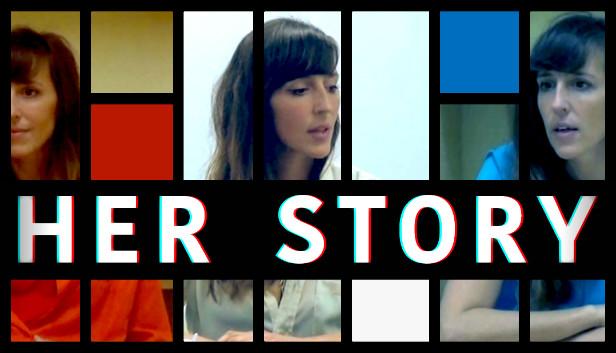Her Story is an interactive film mystery game, designed and directed by Sam Barlow. Because of the old computer interface and simple search function, the player feels like a detective digging into case files. Unlike other mystery games, the murder mystery narrative for Her Story is woven through the game’s non-linear storytelling through database searches, player-driven discovery, and immersive realism.
Players interact with a stimulated desktop interface featuring a police database full of video footage to learn about the mystery. The narrative is delivered through short clips, which players access by typing keywords in a search bar. This method allows players to uncover the story based on their own curiosity and deduction skills, allowing them to experience the fun of discovery and narrative. Whenever I typed in a search word that led to new information (as indicated by a yellow icon on top of each video), I felt a rush of excitement and hurriedly clicked on the video. My experience was likely different than others because I played with a group. My friends and I would have a mini celebration when we uncovered new content, with outbursts like “let’s go!” or “so true.”
Furthermore, the old computer interface supplements the eerie and nostalgic atmosphere, enhancing the mystery as if the player was uncovering something forgotten. This is enhanced when players discover a major plot point, a low opacity image flickers through the screen with flashing sirens. In between searches, we would theorize together and have our theories either shut down or confirmed by the new content. We found the clip where the main character plays “The Dreadful Wind and Rain” on the guitar and assumed that the song was actually about the main character’s experience. We later confirmed that the main character did push their sister’s head under the water and thoughts about drowning them. The narratives that we crafted were dependent on the directions of our search words, making the game an evocative narrative, as the narrative in Her Story is laid out by the designers but dependent on the players.
Rather than having loops and arcs, Her Story divides the story into a network of information that the player can navigate through. Because of this non-linear storytelling, players will arrive at different versions of the story based on what search words they use and what information they discover first. We learned that Hannah had a miscarriage late into her pregnancy. We learned that Hannah invited her pregnant sister to live with her and Simon. Later on, we arrive at a clip where the main character goes off camera to throw up. At this point, we suspected that the main character was the pregnant sister, which is confirmed in an even later clip. However, if we discovered this in reverse, we might’ve assumed that we were still watching pregnant Hannah take the interviews, and that her sister was the one that had already given birth or something. This mechanic extends to the player psychological need of information as players discover how this is her story instead of a typical murder mystery. Slowly, the interviews reveal more about Hannah and her sister Eve rather than Simon, the victim at play, and this gradual understanding of the sisters fulfills this psychological need. One critique for the game is how players may find themselves stuck in the search word loop. We had a large blank in our database that we could not uncover by regular search words, and only after hundreds of attempts did we find that we had to use “yes” in quotation marks to reach them. A suggestion is that after many futile attempts, a hint for search word that isn’t related to the main plot could pop up in the chat box. Another option is to increase the numbers of videos shown for a search word, as the current limit is five even if more videos contain the word. This would appeal to the player’s motivation of competence to make them feel like they’re progressing.
In conclusion, Her Story integrates its narrative through its search word mechanics, allowing the player to engage in a detective-like investigation. By mimicking a dated computer system, the designers control the flow and access to the story, employing a web-like system to create an evocative narrative. In time, the player slowly shifts from solving the case of a missing man to uncovering her story.




